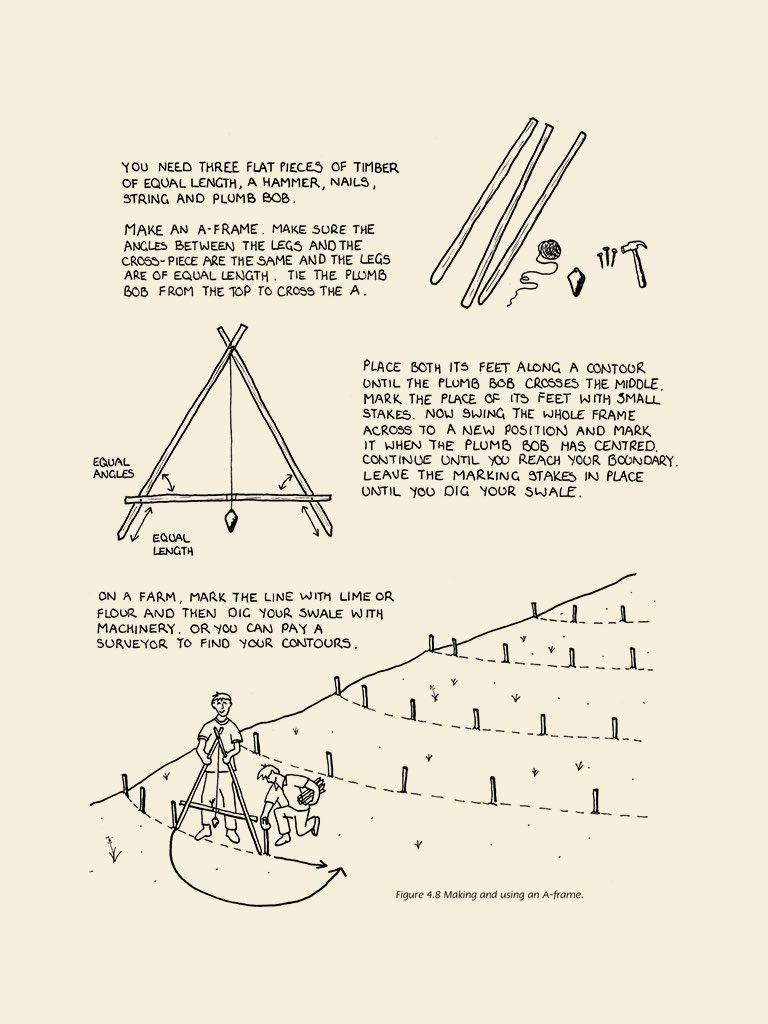I want to tell you all about the garden I got to spend some time in a few years ago that had a few techniques that I thought were really great. First let’s talk about paths and garden bed arrangement and then we can talk about seeds.
I’ll be pretty vague about the location in person because they like their privacy. Pacific northwest maritime not in the city.
It was a fairly flat property but They wanted to see if there was any slope so they built an A-Frame. Three sticks, a string and a nail and you can measure level between two points. (Image from Eaarth users guide to Permaculture by Rosemary Morrow)
So it turned out the yard did have a tiny bit of contour. They measured out the contours from point to point and now they had a series of lines flagged out on the landscape. They let their paths and garden beds follow these lines.
That meant that water stayed put & slowly infiltrated through the paths and into the beds.
The beds were raised with really nice compost and mulched with straw the paths were covered in woodchips and planted with clover.
Each year the paths are dug up & transferred to the bed
The beds were raised with really nice compost and mulched with straw the paths were covered in woodchips and planted with clover.
Each year the paths are dug up & transferred to the bed
In the Pacific Northwest they tried to get their seeds out in March so that the beds with water the seeds with rainwater and at the roots grow deep before the dry season came
Very easy very self-maintaining.
They didn’t water at all except for during emergencies btw.
let me tell you about their seeds. They didn’t worry about overly Designed garden planting. They mixed all sorts of seeds together. In the beds closest to their house they were a little more intensive and intentional with their planning but not much. Basicly an edible meadow
But here’s the interesting thing. While they liked seed-saving they didn’t worry about it much in these beds.
Instead as they went through the beds each day they would pull out anything that they felt was a weed and they would harvest only the things that were not the very best
Instead as they went through the beds each day they would pull out anything that they felt was a weed and they would harvest only the things that were not the very best
Everything that they would call the best versions of their plants they would let go to seed. Then they would cut them down and pile them in big thick multi piles on the beds that they grew in. And that’s it.
Seeds from the very Best would be mulched by their own stocks And the ones that could survive local winter would germinate the next year replanting the bed
Self watering self seeding Very little work once set up
No tillage The soil develops incredible porosity and fungal communities. Some clover planted adds nitrogen. As does a urine bucket with woodchips in the house. The main inputs are path woodchips.
Literally this person put in a lot of time one year and then only did the maintainence through harvest. Over three years there were no more weed seeds and every niche was filled.
From time to time they would bring in interesting seeds and throw them into the garden to fill new niches created by the evolving system. Or throw a handful of soil from a hike from the woods to introduce more advanced soil complexity.
It wasnt neat rows it was a wild free-range community of organisms.
The further beds were more perrenial and were visited weekly rather then daily. The furthest were planted with shrubs and left to their own independence. Only visited monthly.
The further beds were more perrenial and were visited weekly rather then daily. The furthest were planted with shrubs and left to their own independence. Only visited monthly.
Lots and lots of seeds feeling every square inch might make for smaller plants but overall you get more. If you wanna be really experimental you can start creating mixes that are easy to harvest together. But don’t over design let the community work itself out
If things are running along like this you have a really low work to output ratio but if want/ need to you can still give a little more attention and increase productivity. You can thin to give a plant more room or water a little. But it has a strong foundation without

 Read on Twitter
Read on Twitter


